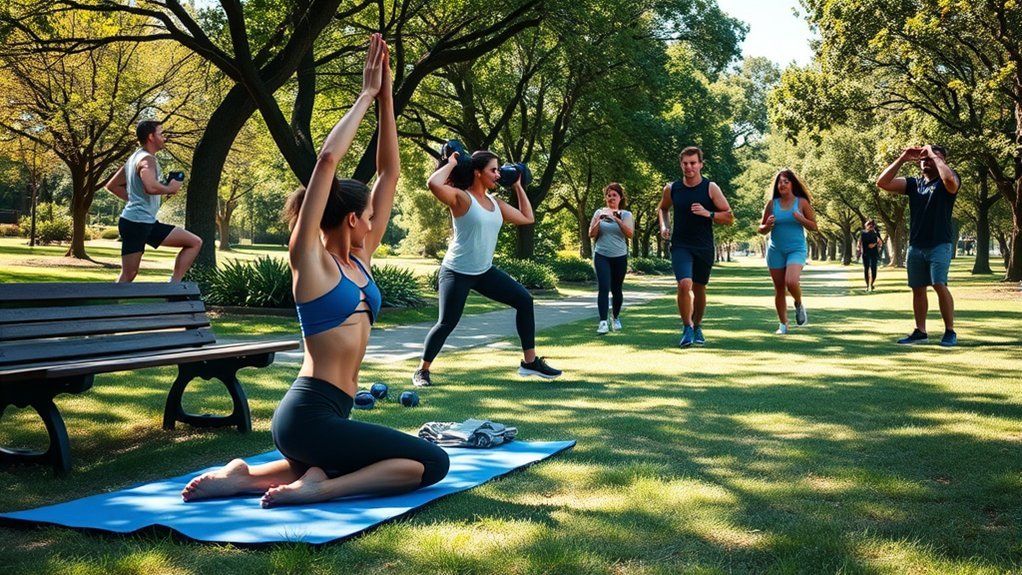Imagine you’re pushing through a workout, feeling great, when suddenly, you pull a muscle. It’s a frustrating setback, but it highlights the importance of following exercise guidelines to prevent injuries. By understanding your fitness level and incorporating proper warm-ups, you can protect your body while achieving your goals. What other strategies can you implement to stay injury-free and maintain your routine? Let’s explore essential prevention tips that can make all the difference in your fitness journey.
Understanding Your Fitness Level

Understanding your fitness level is crucial for tailoring an effective exercise routine. First, assess your current abilities by considering factors like endurance, strength, flexibility, and body composition. You can do this through simple tests, such as timed runs or push-up counts. Knowing where you stand helps you choose exercises that match your capabilities and prevents injuries.
If you’re a beginner, start with low-impact activities like walking or swimming. If you’re more advanced, incorporate strength training or high-intensity workouts. Regularly re-evaluating your fitness level is important as it changes over time. This ongoing assessment guarantees your routine evolves, keeping you challenged and engaged.
Setting Realistic Goals

Setting realistic goals is essential for your fitness journey.
Start by evaluating your current fitness level to understand what’s achievable for you. Once you’ve got a clear picture, break your goals into manageable steps to keep you motivated and on track.
Assess Your Current Fitness
How do you know where to start on your fitness journey? First, it’s essential to assess your current fitness level.
Take some time to evaluate your strength, endurance, flexibility, and overall health. Consider how often you exercise now and what activities you enjoy. You might also want to track your daily habits, such as your diet and sleep patterns.
This self-assessment helps you identify areas for improvement and sets the foundation for your goals. Don’t forget to consult with a healthcare professional for personalized advice, especially if you have existing health concerns.
Break Goals Into Steps
Breaking your fitness goals into manageable steps makes the journey less overwhelming and more achievable. Start by identifying your ultimate goal, whether it’s losing weight, building muscle, or improving endurance.
Next, break that goal down into smaller, specific milestones. For example, if you want to lose 20 pounds, aim to lose 1-2 pounds each week. This creates a clear path and keeps you motivated.
Set deadlines for each milestone, and track your progress regularly. Celebrate your successes, no matter how small, to maintain enthusiasm.
Finally, be flexible; if something isn’t working, adjust your plan. By breaking your goals into steps, you’ll find the process more manageable and enjoyable, leading to lasting results.
Warming Up Properly

Why is warming up properly vital before diving into your workout? Warming up prepares your body for physical activity by increasing blood flow to your muscles and raising your heart rate. This not only enhances your performance but also reduces the risk of injury.
Spend about 5 to 10 minutes on dynamic stretches or light aerobic exercises to get your body moving. Focus on major muscle groups you’ll be using during your workout. These movements improve flexibility and range of motion, making your workout more effective.
Using Correct Form and Technique
Using correct form and technique is essential for maximizing your workout’s effectiveness and minimizing the risk of injury. When you perform exercises with proper alignment and movement patterns, you engage the right muscles and maintain control. Here’s a quick guide to help you focus on form:
| Exercise | Common Mistake | Correct Technique |
|---|---|---|
| Squats | Knees caving inward | Keep knees aligned with toes |
| Push-ups | Dropping hips | Maintain a straight line from head to heels |
| Deadlifts | Rounding back | Keep a neutral spine throughout |
| Lunges | Leaning forward | Keep your torso upright and knees behind toes |
| Planks | Sagging hips | Engage your core and keep a straight line |
Listening to Your Body
Even with perfect form, it’s important to pay attention to how your body feels during exercise. Listening to your body can prevent injuries and enhance your performance.
If you experience pain, discomfort, or unusual fatigue, don’t ignore those signals; they’re your body’s way of communicating. Adjust your intensity, modify your movements, or take a break if something doesn’t feel right.
Remember, soreness is normal, but sharp pain isn’t. Check in with yourself throughout your workout. Are you feeling fatigued? It might be a sign to slow down or switch exercises.
Incorporating Rest and Recovery
Incorporating rest and recovery into your fitness routine is just as important as the workouts themselves, as it allows your body to heal and grow stronger.
Without adequate recovery, you risk burnout, injury, and diminished performance. Schedule at least one or two rest days each week to let your muscles recuperate.
Inadequate recovery can lead to burnout and injury; prioritize one or two rest days weekly for optimal muscle recuperation.
Listen to your body; if you’re feeling fatigued or sore, consider taking an extra day off or engaging in low-impact activities like yoga or stretching.
Sleep is also essential, so aim for 7-9 hours each night to support your recovery process.
Staying Hydrated
Recovery isn’t just about rest; it also involves hydration, which plays an essential role in your overall fitness. Staying hydrated helps maintain your body’s fluid balance, supports muscle function, and aids in nutrient transport.
When you exercise, you lose water through sweat, and if you don’t replenish those fluids, you risk dehydration, fatigue, and decreased performance. Aim to drink water before, during, and after your workouts. A good rule of thumb is to consume about 17-20 ounces of water two hours before exercising and 8 ounces every 20 minutes during your workout.
Listen to your body—thirst is an indicator, but don’t wait until you’re thirsty to hydrate. Prioritizing hydration will enhance your recovery and boost your overall performance.
Cross-Training for Balance
While you may have your favorite workout routines, cross-training can greatly enhance your overall fitness and prevent injury. By incorporating different types of exercises into your routine, you engage various muscle groups and improve your balance.
For example, if you’re a runner, adding cycling or swimming can strengthen your legs without overstraining them. Meanwhile, yoga or Pilates can improve your core stability and flexibility, both vital for balance.
Cross-training also helps keep workouts fresh and exciting, reducing the risk of burnout. It’s essential to listen to your body and mix low-impact activities with higher-intensity workouts.
This way, you’ll build strength and endurance, ultimately leading to better performance in your primary activity while keeping injuries at bay.
Staying Motivated and Consistent
To stay motivated and consistent in your fitness journey, it’s crucial to set clear, achievable goals that resonate with your personal aspirations. Break these goals into smaller milestones to celebrate your progress along the way.
Incorporate variety into your routine to keep things fresh and exciting—try new workouts or outdoor activities. Find a workout buddy or join a class for added accountability and social interaction.
Track your workouts and achievements to see how far you’ve come, and don’t hesitate to adjust your goals as needed. Remember that consistency is key; even small efforts add up.
Finally, remind yourself of the benefits of staying active, whether it’s improved mood, better health, or enhanced energy levels. Stay focused, and enjoy the journey!
Frequently Asked Questions
What Types of Exercise Are Best for Beginners?
For beginners, low-impact exercises like walking, swimming, and cycling are great choices. They build endurance without overwhelming your body. Incorporating strength training with bodyweight exercises can also enhance your overall fitness and confidence.
How Can I Avoid Injuries While Exercising?
To keep your body happy while exercising, warm up properly, listen to your body’s signals, and mix up your routine. Gradually increase intensity, wear the right gear, and don’t skip rest days. You’ll thrive!
How Often Should I Change My Workout Routine?
You should change your workout routine every four to six weeks. This keeps your body challenged, helps prevent plateaus, and reduces the risk of overuse injuries. Listen to your body and adjust as needed.
What Should I Eat Before and After Exercising?
Before exercising, grab a snack rich in carbs and protein, like a banana with peanut butter. After your workout, fuel up with a balanced meal, including lean protein and complex carbs, to aid recovery.
How Can I Stay Motivated on Tough Days?
On tough days, remind yourself of your goals, visualize success, and break workouts into smaller, manageable tasks. Celebrate each achievement, and consider working out with a friend to boost motivation and accountability.
Conclusion
By following these exercise guidelines, you can greatly reduce your risk of injury and enjoy a more rewarding fitness journey. Did you know that nearly 80% of all sports injuries are preventable with proper technique and preparation? Staying mindful of your fitness level, warming up, and incorporating rest can make all the difference. So, keep these tips in mind, stay motivated, and watch your progress soar while keeping your body safe and healthy.
